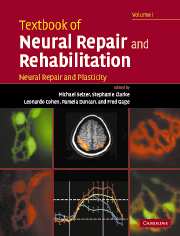Book contents
- Frontmatter
- Contents
- Contents (contents of Volume II)
- Preface
- Contributors (contributors of Volume I)
- Contributors (contributors of Volume II)
- Neural repair and rehabilitation: an introduction
- Section A Neural plasticity
- Section A1 Cellular and molecular mechanisms of neural plasticity
- Section A2 Functional plasticity in CNS system
- Section A3 Plasticity after injury to the CNS
- Section B1 Neural repair
- Section B2 Determinants of regeneration in the injured nervous system
- Section B3 Promotion of regeneration in the injured nervous system
- 25 Cell replacement in spinal cord injury
- 26 Dysfunction and recovery in demyelinated and dysmyelinated axons
- 27 Role of Schwann cells in peripheral nerve regeneration
- 28 Transplantation of Schwann cells and olfactory ensheathing cells to promote regeneration in the CNS
- 29 Trophic factor delivery by gene therapy
- 30 Assessment of sensorimotor function after spinal cord injury and repair
- Section B4 Translational research: application to human neural injury
- Index
26 - Dysfunction and recovery in demyelinated and dysmyelinated axons
from Section B3 - Promotion of regeneration in the injured nervous system
Published online by Cambridge University Press: 05 March 2012
- Frontmatter
- Contents
- Contents (contents of Volume II)
- Preface
- Contributors (contributors of Volume I)
- Contributors (contributors of Volume II)
- Neural repair and rehabilitation: an introduction
- Section A Neural plasticity
- Section A1 Cellular and molecular mechanisms of neural plasticity
- Section A2 Functional plasticity in CNS system
- Section A3 Plasticity after injury to the CNS
- Section B1 Neural repair
- Section B2 Determinants of regeneration in the injured nervous system
- Section B3 Promotion of regeneration in the injured nervous system
- 25 Cell replacement in spinal cord injury
- 26 Dysfunction and recovery in demyelinated and dysmyelinated axons
- 27 Role of Schwann cells in peripheral nerve regeneration
- 28 Transplantation of Schwann cells and olfactory ensheathing cells to promote regeneration in the CNS
- 29 Trophic factor delivery by gene therapy
- 30 Assessment of sensorimotor function after spinal cord injury and repair
- Section B4 Translational research: application to human neural injury
- Index
Summary
Since information is transmitted from site to site within the nervous system via the conduction of sequences of action potentials, it is not surprising that the need to optimize the conduction time has shaped the evolution of nerve fibers. In axons without myelin, which are present both in lower species and in phylogenetically old tracts in higher species, action potentials travel at a speed (the conduction velocity) that is proportional to diameter½. Thus, in order to achieve a faster speed of conduction, species that lack myelin have to substantially enlarge their axons. In the squid which lacks myelin, axons evolved to be as large as 400–900 µm in diameter, a fortuitous specialization which enabled early electrophysiologists to study the ionic basis for nerve impulses conduction through the first recordings from within single nerve fibers. Increased conduction speed in these axons comes at a price: an increase in size. In higher species, on the other hand, high conduction velocities are achieved in some axons by ensheathment with myelin. Myelinated fibers are subject to several types of pathology including dysmyelination (failure to form normal myelin) and demyelination (loss of myelin after it has been formed). This chapter will discuss the organization and function of normal myelinated axons and of demyelinated and dysmyelinated axons.
The myelinated axon and its sheath
The myelinated fiber consists of an axon and its surrounding myelin sheaths. Schwann cells in the peripheral nervous system (PNS), and oligodendrocytes in the central nervous system (CNS), produce myelin.
Keywords
- Type
- Chapter
- Information
- Textbook of Neural Repair and Rehabilitation , pp. 468 - 486Publisher: Cambridge University PressPrint publication year: 2006



